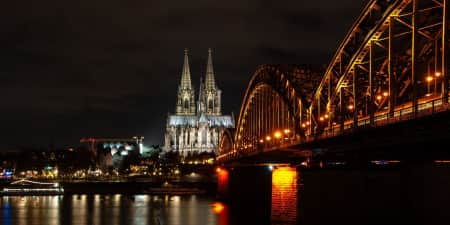How It's Built: The Cologne Cathedral
There are few buildings in the world that are able to match the aesthetic and beauty of churches and religious structures. Oftentimes, these historical and architectural establishments were the most well-funded projects of their time and were designed by the greatest architects, making for some great edifices.
The Cologne Cathedral in Cologne, Germany is no different. Standing with its two large spires, it is the second-largest building in Cologne and the most popular tourist attraction in the city. Located in central Cologne and not too far from the Rhine River, it not only stands as an amazing backdrop to the city at the height of 157 meters but also provides amazing views from the top.
However, as the history of the cathedral will show, it not only serves as a religious sanctuary but also as a demonstration of perseverance and dedication.
Why Was The Cologne Cathedral Built?
Originally designated as a building for the Archbishop of Cologne, the Cologne Cathedral also currently holds the shrine of The Three Wise Men, one of the most famous biblical stories. This shrine was brought back to Cologne in the mid-12th century by Archbishop Rainald von Dassel. What was once a popular destination for Christian visitors to come and worship has since become a building that is respected for its breathtaking Gothic architecture and tall spires.
When Was The Cologne Cathedral Built?
While construction on the cathedral started in 1248, the building was not finished until 1880. However, this was due to an almost 300-year stoppage between 1560 and the 1840s.
The site chosen to build the cathedral had been the ground for many previous religious institutions as well, making it a fitting place for the new structure. This includes a previous cathedral that was known as "the oldest cathedral" which was advocated for by Maternus, Cologne's first bishop. It is believed that the Archbishop, Konrad von Hochstaden, laid the first foundation stone in August of 1248. The eastern part of the cathedral was completed in 1322 and construction continued until about 1560 before running out of funding. One of the reasons why historians think construction stopped was that Gothic architecture had lost its place and value in society.
Attempts to restart the construction had taken place over the next 300 years but with little luck. However, in the 1840s, there was a push by the public and the Protestant Prussian Court to finish the cathedral. With the power of the city and citizens, as well as government organizations, funding was raised and the construction was restarted in 1842. The first new foundation stone of the restarted build was laid by King Frederick William IV.
When the project was continued, it also was encouraged by architects and artists who believed that middle age and Gothic designs had interest again. As such, despite the massive delay and block of time between construction, the relaunch of the building was still in line with the original plans and blueprints. When the Cologne Cathedral was finished in 1880 it was well believed to be the tallest tower in the world at 515 feet (157 meters). However, that designation was short-lived and passed by another building in 1884.
Who Built The Cologne Cathedral?
Because of all of the delays and just how long it took to finish the structure, there were tons of people involved with the completion of the project. The original design was made by Gerhard of Reil, a stonemason who took inspiration from other cathedrals that were designed and built across Europe. The idea behind his design was to build a cathedral that, from above, looked to be in the shape of a Latin Cross, which is standard for most Gothic cathedrals.
When the building of the Cologne Cathedral was continued in 1842, it was architects Ernst Friedrich Zwirner and Richard Voigtel who took on ownership of the process. Due to the respect they had for the original designs, they did not alter much from the original plans and finished the work that Gerhard of Reil started.
The interior of the building is also stunning. With some of the highest walls of a church in the entire world, the features across the ceiling of the building are a testament to the artistry of the builders as well as their construction ingenuity. Building that type of interior without the tools used today like aerial lifts is an amazing feat.
Gothic cathedral interiors are known for their emphasis on high ceilings and light-filled spaces as they are designed to reflect that of the deity they worship. Because of this desire, architects and designers in those years were forced to reimagine how engineering and construction could build these types of interiors. This led to innovations like large vaulted ceilings, large stain-glassed windows, pointed arches that provide more space for light as well as loading reductions, and flying buttresses. Together, these designs led to many innovations that we have today and reimagined what the standard post and beam buildings could look like. View the video below to see more:
More recently, there hasn't been any architect who's led the alterations to the building. However, during World War II, the cathedral did face some damage and underwent many repairs both internally and externally. Now, it is Germany's most visited landmark with about 20,000 visitors per day.
Visiting The Cologne Cathedral
Designated as a World Heritage Site in 1996 due to its influence in Germany and as a monument for Gothic Architecture and Catholicism, visiting the Cologne Cathedral is a popular activity for tourists. Visiting the cathedral is free of charge unless you want a tour, and you can even get a beautiful view of the city of Cologne from the top of the southern tower, which is about 97 meters high. However, this does require you to walk up 533 steps as there is no lift or elevator.

